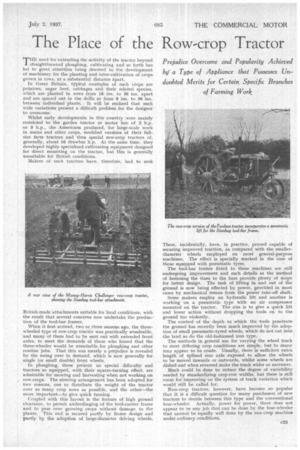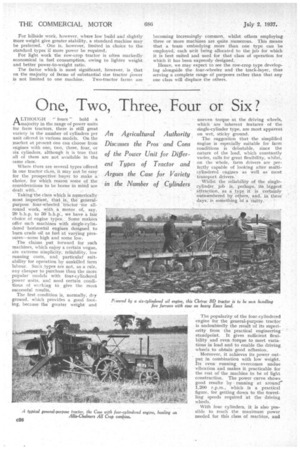The Place of the Row-crop Tractor
Page 71

Page 72

If you've noticed an error in this article please click here to report it so we can fix it.
Prejudice Overcome and Popularity Achieved by a Type of Appliance that Possesses Undoubted Merits for Certain Specific Branches of Farming Work
THE need for extending the activity of the tractor beyond straightforward ploughing, cultivating and so forth has led to great attention being devoted to the development of machinery for the planting and inter-cultivation of crops grown in rows, at a substantial distance apart.
In Great Britain, typical examples of such crops are potatoes, sugar beet, cabbages and their related species, which are planted in rows from 18 ins. to 36 ins, apart and are spaced out in the drills at from 8 ins. to 36 ins. between individual plants. It will be realized that such Wide variations present a difficult problem for the designer to overcome.
Whilst early developments in this country were mainly restricted to the garden tractor or motor hoe of 2 h.p. or 3 hp,, the Americans produced, for large-scale work in maize and other crops, modified versions of their fullsize farm tractors and then special row-crop tractors of, generally, about 16 drawbar h.p. At the same time, they developed highly specialized cultivating equipment designed for direct mounting on the tractor, but this is generally unsuitable for British conditions.
Makers of such tractors have, therefore, had to seek British-made attachments suitable for local conditions, with the result that several concerns now undertake the produc-' tion of the tool-bar frames.
When it first arrived, two or three seasons ago, the threewheeled type of row-crop tractor was practically unsaleable, -and many of them had to be sent out with extended front' axles, to meet the demands of those who feared that the three-wheeler would be unsuitable for ploughing and other routine jobs. That this was merely a prejudice is revealed by the swing over in demand, which is now generally for single (or small double) front wheels.
In ploughing, these present no special difficulty and tractors so equipped, with their square-turning effect, are admirable for mowing and harvesting when not working on row-crops. The steering arrangement has been adopted for two reasons, one to distribute the weight of the tractor over as many crop rows as possible, and the other—the more important—to give quick turning.
Ceupled with this layout is the feature of high ground clearance, to permit underslinging of the tool-carrier frame and to pass over growing crops without damage to the plants. This end is Secured partly by frame design and partly by the adoption of large-diameter driving wheels. These, incidentally, have, in practice, proved capable of securing improved traction, as compared with the smallerdiameter wheels employed on most general-purpose machines. The effect is specially marked in the case of those equipped with pneumatic tyres.
The tool-bar frames fitted to these machines are still undergoing improvement and such details as the method of fastening the tines to the bars provide plenty of scope for better design. The task of lifting in and out of the ground is now being effected by power, provided in most cases by mechanical means from the power take-off shaft.
Some makers employ an hydraulic lift and another is working on a pneumatic type with an air compressor mounted on the tractor. The aim is to give a quick lift and lower action without dropping the tools on to the ground too violently.
The control of the depth to which the tools penetrate the ground has recently been much improved by the adoption of small pneumatic-tyred wheels, which do not cut into the land as do the old-fashioned iron type.
The methods in general use for varying the wheel track to meet differing crop conditions are simple, but to many may appear to be crude. Usually, there is sufficient extra length of splined rear axle exposed to allow the wheels to be moved inwards or outwards, whilst some wheels are dished and when reversed make the track wider or narrower.
Much could be done to reduce the degree of variability needed by standardizing crop-row widths, but there is still room for improving on the system of track variation which would still be called for.
Row-crop tractors, however, have become so popular that it is a difficult question for many purchasers of new tractors to decide between this type and the conventional four-wheeler. Actually, power for power, there does not appear to be any job that can be done by the four-wheeler that cannot he equally well done by the row-crop machine under ordinary conditions. For hillside work, however, where low build and slightly more weight give greater stability, a standard machine may be preferred. One is, however, limited in choice to the standard types if more power be required.
For light work the row-crop tractor is often markedly economical in fuel consumption, owing to lighter weight and better power-to-weight ratio.
The factor which is most significant, however, is . that on the majority of farms of substantial size tractor power is not limited to one machine. Two-tractor farms are becoming increasingly common, whilst others employing three or more machines are quite numerous. This means that a team embodying more than one type can be employed, each unit being allocated to the job for which it is hest suited and used for that class of operation for which it has been expressly designed.
Hence, we may expect to see the row-crop type developing alongside the • four-wheeler and the track-layer, thus serving a complete range of purposes rather than that any one class will displace the others.




















































































































































